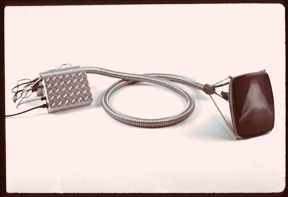

[ Metro | Metroactive Central | Archives ]
Rath of the Machines
 Snifter: A mixed-media electronic construction by Alan Rath Sculptor Alan Rath questions the promises of technology By David M. Rath In the early '60s, poet Richard Brautigan envisioned a world where humanity would be "watched over by machines of loving grace." The idea, as Brautigan described it, was to have life's drudge work performed by machines and life's pleasures pursued by the world's workers. As it turned out, the machines wound up enslaving us with information overload--and are now in the process of rendering us obsolete altogether. Progress? Better living through technology? Alan Rath, an MIT-trained engineer turned sculptor, doesn't buy it. Rath, 36, is no latter-day Luddite; he understands computers very well. So well, in fact, that he revels in their components, building fantastic, anthropomorphic creations out of circuit boards, memory chips, frame buffers and wires--all the while casting a cold eye on technology's dubious promises. Those promises are the subject of the Oakland artist's current exhibition at the Palo Alto Cultural Center. At first glance, Rath's sculptures seem benign, even playful, the sort of thing you'd want around the house if you were allergic to cats. That's because Rath has a disconcerting habit of creating machines that appear to be living. His grafting of lifelike qualities onto electronic gizmos explores how people project human qualities onto machines and how, in turn, machines are perceived as having personalities. One of the most stirring examples of his method is Off the Wall, an installation that consumes a good chunk of the gallery's foyer. It consists of silently pulsating speaker cones suspended from the ceiling by wires to create the appearance of a living, breathing organism--an electronic jungle controlled by an unseen intelligence. The sculpture's loop form recalls Paul Klee, while its implied "functions" bring to mind what Alexander Calder might have built had he gone scavenging, as Rath does, in electronics surplus stores. (Savvy videophiles will also detect in other parts of this show strong similarities between Rath's art and the recent robotic sculptures of the acclaimed conceptual artist Nam June Paik.) This conflation of animate and inanimate reflects Rath's own intimacy with electronics, a journey that began, innocently enough, when at age 6 he shoved a hairpin in a wall outlet. At age 12, he started building transistorized circuits; four years later, he designed stage lights for a three-day rock concert. Rath entered MIT to study physics but switched to electrical engineering, later experimenting with aesthetics at MIT's Visual Language Workshop, the Architecture Machine Group and the Center for Advanced Visual Studies. By the mid '80s, after a trip to Europe during which he was profoundly influenced by the kinetic work of Jean Tinguely, Rath started building the digital video sculptures that have won him solo exhibitions in the US, Europe and Asia. Although these objects reveal his obvious love of electronics, they also focus on the darker side of our obsession with computers--an obsession that in most cases has little to do with any sort of quest for knowledge. As net heads everywhere know, online chat-room traffic often takes place with one hand on the keyboard and the other in the lap. Tongue Tied, an accretion of twisted cables and electronic boxes that hangs in a beautiful state of equipoise, comments on that phenomena. Its most prominent feature is a small cathode ray tube that spews digitized images of an open mouth whose wagging tongue suggests oral sex in smutty, low-resolution shades of fluorescent green. The attraction/repulsion dynamic produced carries a sharp, unmistakable message: that the virtual life is no life. Moist, a simpler contraption, ups the ante in this game of cruel titillation by juxtaposing the sensuality of the same beckoning mouth with the obvious dryness of the electronic components that produced it. Message in a Bottle, a wire-and-circuit stuffed jar containing a tiny CRT, engages in some clever punning on the word "digital" through its presentation of a hand signing. I don't know sign language, so I can't tell you what's being said, but the use of actual digits communicating in the realm of ones and zeroes is a clever piece of mockery that cuts straight to the heart of our faith in technological progress. If there is a weakness in the presentation, it's the glibness of it all. Ironically, though, that may also be its strength. Where conceptualist video artists such as Paik and Bruce Nauman are often content to explore the intrinsic qualities of their medium, Rath chooses to employ the sculptural possibilities of electronic hardware. In this way, he can comment directly on a binary universe in which sensations, images, emotions and events can be randomly and mindlessly transformed into their opposites by pointing and clicking. Still, despite his reservations, Rath isn't advocating that we forsake our computers. The truth is that he can't imagine a world unplugged. As he told an interviewer, "Technology is like your parents. It's a given and you have to learn to live with it. ... Our lives are immersed in technology. We can't wish it didn't exist." Rath, if nothing else, makes it fun to contemplate technology's limitations--and its profound threats to our privacy, our sexuality and our corporeal identity. [ Metro | Metroactive Central | Archives ]
| ||||||||||||||||||||||||||||||
This page was designed and created by the Boulevards team.
Copyright © 1995 Metro Publishing and Virtual Valley, Inc.